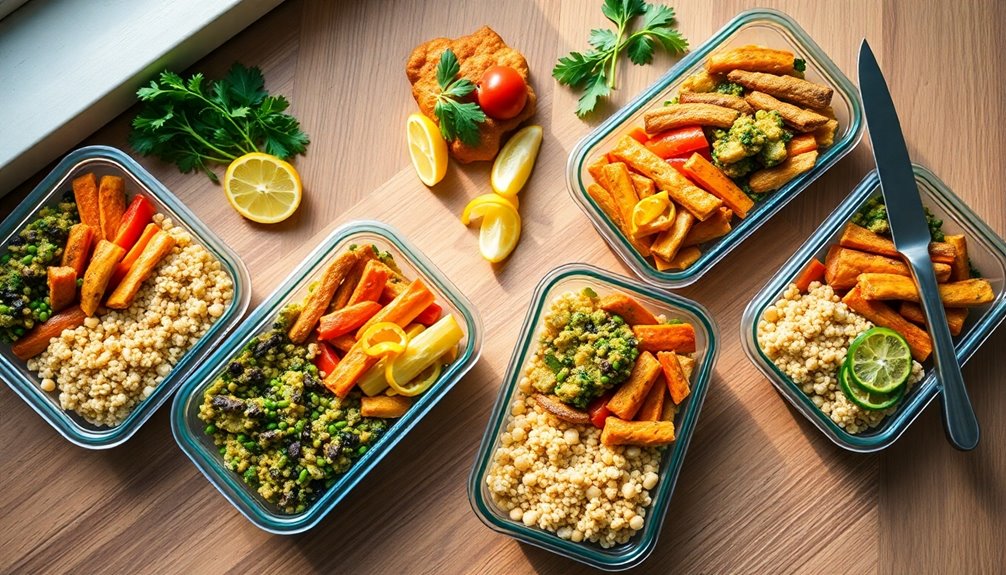To meal prep balanced lunches for the week, start by dedicating a day to plan your meals and create a shopping list. Focus on incorporating proteins like lean chicken and legumes, healthy fats such as avocados and nuts, and whole grains like quinoa and brown rice. Invest in quality storage containers and implement batch cooking techniques to save time. Don't forget to use colorful fruits and vegetables for added nutrients. After cooking, let your meals cool before storing them in the fridge. Follow portion guidelines for balanced servings, ensuring you stay satisfied throughout the week. There's more to explore for even better results.
Key Takeaways
- Dedicate a specific day to plan and prepare balanced lunches, incorporating proteins, whole grains, healthy fats, and a variety of fruits and vegetables.
- Create a detailed shopping list based on your meal plan to ensure you have all necessary ingredients for the week.
- Master batch cooking techniques, like using a slow cooker or Instant Pot, to efficiently prepare larger quantities of versatile ingredients.
- Use high-quality, BPA-free storage containers to properly store meals, and label them for easy identification during the week.
- Follow serving size guidelines to maintain balanced nutrition, and reheat meals to at least 165°F (74°C) for safe consumption.
Benefits of Meal Prepping
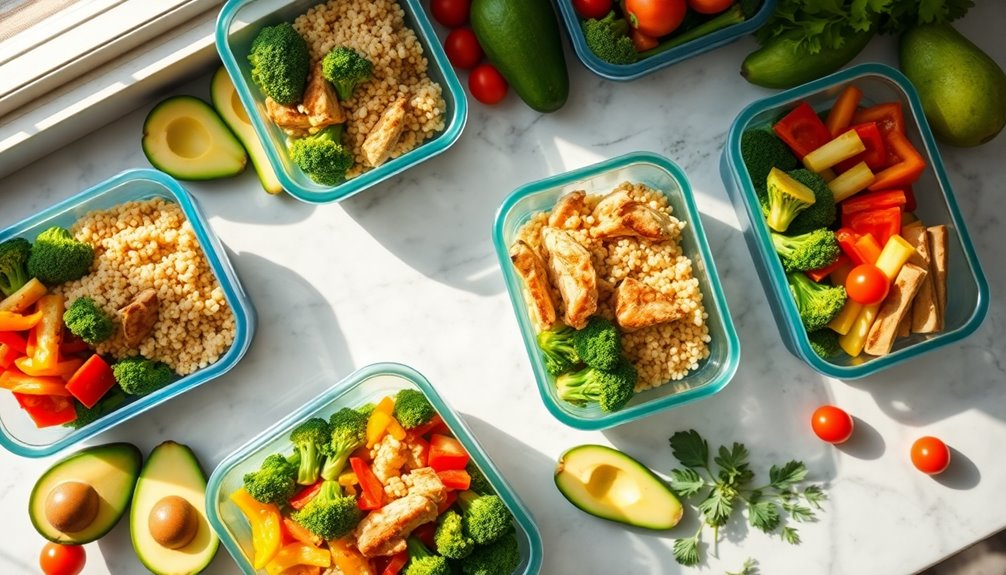
When you embrace meal prepping, you not only save time during your busy week but also set yourself up for healthier eating habits. By planning and preparing your meals in advance, you can maximize your time management, ensuring you've got nutritious options ready to go when life gets hectic. You won't find yourself scrambling for lunch or relying on fast food, which often leads to unhealthy choices.
Meal prepping also leads to significant cost savings. When you buy ingredients in bulk and prepare meals at home, you cut down on food waste and avoid the premium prices associated with takeout or convenience foods. Research shows that individuals who meal prep can save up to 50% on their grocery bills, making it a smart financial choice.
Additionally, meal prepping fosters a sense of community. When you share recipes and ideas with friends or family, you create a supportive network that encourages everyone to eat healthier. This shared experience not only enhances your meal prep journey but also strengthens your relationships.
As you start meal prepping, you'll find that the benefits extend beyond just saving time and money. You'll develop a greater awareness of what you're putting into your body, ultimately leading to improved health and well-being. So, take the plunge into meal prepping; it's an empowering step toward a more organized and fulfilling life.
Essential Meal Prep Tools
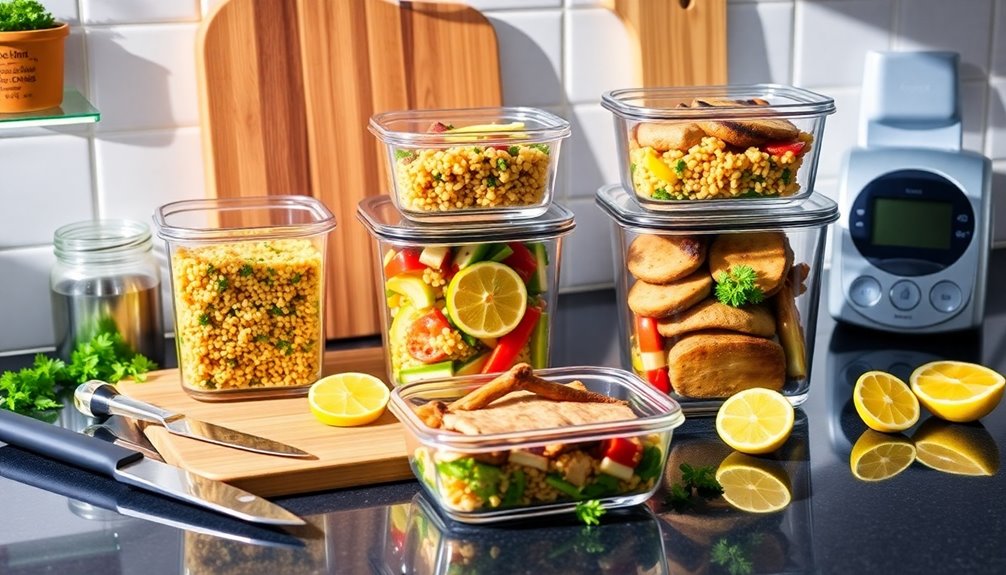
Meal prepping effectively sets the stage for success, but having the right tools can make the process even smoother. To kick off your meal prep journey, invest in high-quality storage containers. Look for stackable, airtight options that help with kitchen organization and keep your meals fresher for longer. Clear containers also let you quickly identify what you've prepped, minimizing the chances of food waste.
Next, a good set of kitchen scales and measuring cups can greatly enhance your time management. Accurately measuring ingredients helps guarantee that you're not only portioning correctly but also following recipes more efficiently, which can save you from last-minute modifications.
A sharp knife and cutting board are essential for efficient chopping and dicing. You'll find that having the right tools reduces prep time and makes the whole process more enjoyable. Additionally, learning the art of hand sharpening can significantly enhance your knife's performance, resulting in better meal prep outcomes.
For those who love to batch cook, consider investing in a slow cooker or an Instant Pot. These appliances can save you hours in the kitchen, allowing you to focus on other tasks while your meals cook.
Lastly, don't overlook a quality meal planner or digital app. Planning your meals ahead of time can streamline your grocery shopping and help you stay organized throughout the week. With these essential meal prep tools at your disposal, you'll create a system that not only fosters successful meal prepping but also enriches your overall kitchen experience.
Choosing Balanced Ingredients
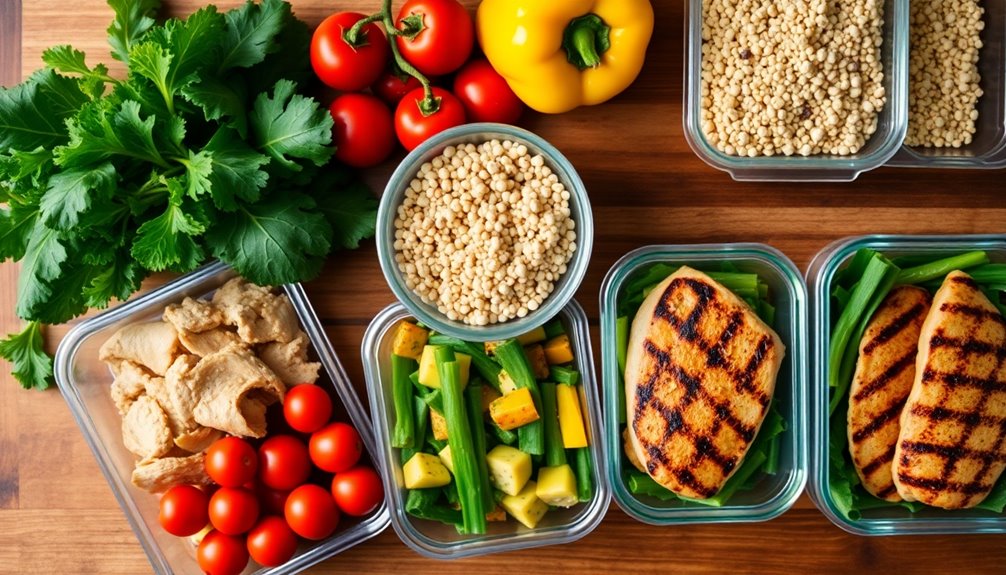
Balancing your meals starts with selecting the right ingredients that nourish your body and satisfy your taste buds. To achieve nutritional balance, focus on ingredient variety. This means including a mix of proteins, healthy fats, whole grains, and plenty of fruits and vegetables. By diversifying your ingredients, you not only enhance the flavors of your meals but also make sure you're getting a wide range of essential nutrients.
Start with proteins like lean chicken, tofu, or legumes. These options provide the building blocks your body needs for muscle repair and energy.
Next, incorporate healthy fats such as avocados, nuts, or olive oil, which support heart health and help you feel full longer.
Whole grains like quinoa, brown rice, or farro are excellent sources of fiber, promoting digestive health and keeping you satisfied throughout the day.
Don't forget to load up on colorful fruits and vegetables! They're packed with vitamins, minerals, and antioxidants that boost your immune system and overall well-being. Aim for at least five servings of these vibrant foods to optimize your meals.
When you choose ingredients that complement each other in taste and nutrition, you create a satisfying and balanced dish. Remember, meal prepping doesn't have to be boring or repetitive. Embrace ingredient variety to keep your lunches exciting and fulfilling. You'll not only enjoy your meals more, but you'll also cater to your body's nutritional needs, allowing you to thrive throughout the week.
Planning Your Weekly Menu
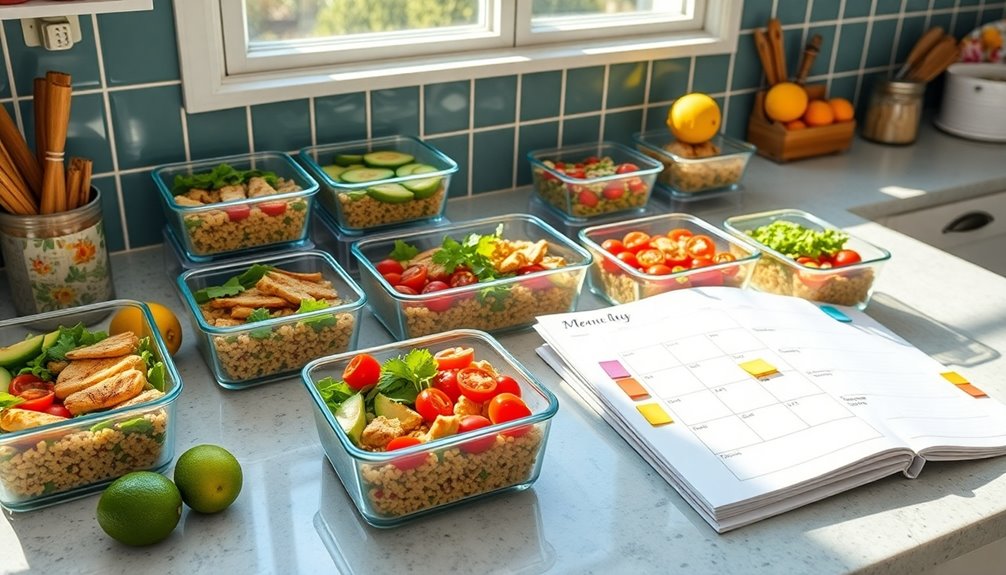
Having a well-structured weekly menu can save you time and help you stay committed to healthy eating. Start by dedicating a few minutes each week to plan your lunches. This step not only streamlines your grocery shopping but also guarantees you have a variety of meals to look forward to.
Look for recipe inspiration from your favorite cookbooks, websites, or social media platforms. Aim for a mix of proteins, vegetables, and whole grains to keep your meals balanced and exciting. Consider incorporating themes for each day, like Meatless Monday or Taco Tuesday, to make planning easier.
Once you've settled on your recipes, create a detailed shopping list. This won't only simplify your grocery shopping but also help you stick to a budget. Buying in bulk can save you money, especially for ingredients you use frequently.
Effective time management is pivotal in making meal prep a sustainable habit. Allocate specific days for cooking, and try to prepare multiple portions at once. By cooking larger batches, you'll save time and reduce the temptation to order takeout.
Cooking Techniques for Meal Prep
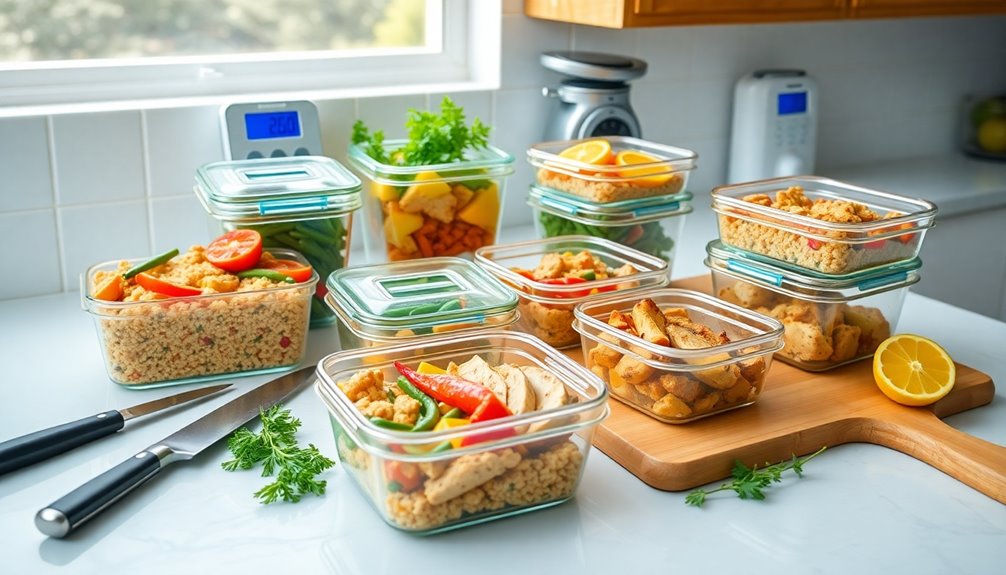
Efficient meal prep relies heavily on mastering a few essential cooking techniques. By honing these skills, you can create delicious, balanced lunches that make meal prep feel less challenging and more invigorating. Here are three key techniques to focus on:
- Batch cooking: Prepare large quantities of grains, proteins, or vegetables all at once.
- One-pan meals: Use a single pan to cook multiple ingredients together, saving time and minimizing cleanup.
- Blanching and freezing: Quickly cook vegetables in boiling water, then freeze them for easy access later.
When it comes to flavor combinations, don't shy away from experimenting. You can mix and match ingredients to create diverse lunches throughout the week. For instance, pair roasted sweet potatoes with black beans and avocado for a hearty bowl, or combine quinoa with roasted vegetables and a revitalizing dressing for a rejuvenating salad.
Seasoning options are equally important. Stock your pantry with a variety of herbs, spices, and condiments to elevate your meals. A sprinkle of cumin can transform a basic bean dish, while a dash of balsamic vinegar can liven up roasted veggies. Additionally, incorporating plant-based diets into your meal prep can enhance your overall health and well-being.
Portion Control and Serving Sizes
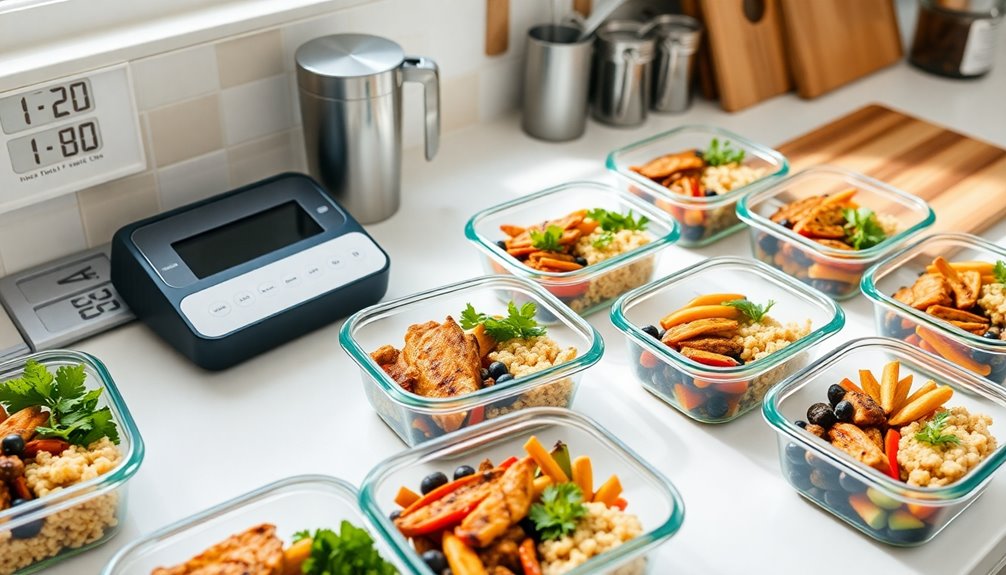
Mastering portion control and serving sizes is crucial for creating balanced lunches that support your dietary goals. When you know how much food to include in each meal, you'll not only stay on track with your nutrition but also feel more satisfied. Here are some practical tips to help you measure your portions effectively.
Using measuring utensils and weight scales can greatly enhance accuracy. For example, a kitchen scale can aid you in determining the precise weight of proteins, while measuring cups and spoons can help you use the correct amounts of grains and vegetables. Visual guides and portion plates can also be invaluable tools. They offer a simple way to visualize appropriate serving sizes, making it easier to create balanced meals.
Here's a quick reference table to help you with serving sizes:
| Food Group | Recommended Portion Size |
|---|---|
| Protein (meat, fish, tofu) | 3-4 oz (size of a deck of cards) |
| Grains (rice, pasta) | 1/2 cup cooked (size of a cupcake wrapper) |
| Vegetables | 1 cup raw or 1/2 cup cooked (size of a baseball) |
| Healthy fats (avocado, nuts) | 1-2 tbsp (size of a golf ball) |
Storing Meal Prep Containers
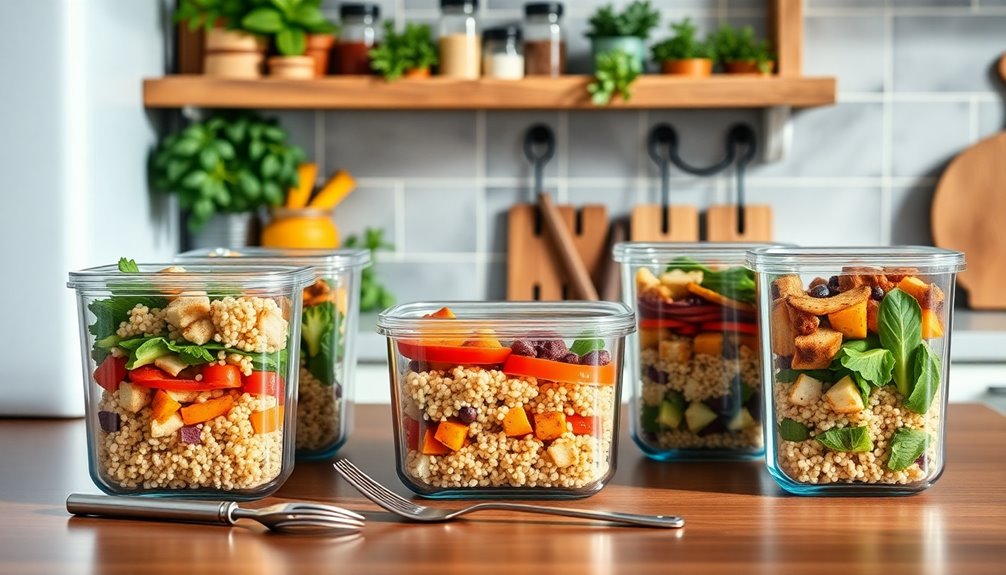
When it comes to meal prepping, properly storing your containers is just as crucial as the meals themselves. If you want to guarantee your lunches stay fresh and your prep routine runs smoothly, consider these best practices:
- Choose the appropriate reusable containers: Opt for BPA-free, microwave-safe options that won't warp or stain.
- Organize by size and type: Group similar containers together to make finding what you need easier.
- Implement proper labeling: Clearly label each container with the meal name and date to avoid confusion.
After you've cooked and portioned your meals, let them cool down to room temperature before sealing them in your reusable containers. This helps prevent moisture buildup, which can lead to spoilage.
Next, stack your containers neatly in the fridge or freezer, making sure you don't overcrowd them. Air circulation is key for keeping your meals fresh.
Make labeling a part of your routine. Use tape and a permanent marker or invest in reusable labels. This small step can save you from accidental food waste and keep your meal prep organized.
Lastly, keep an inventory of what you have stored. This not only helps you plan your lunches for the week but also fosters a sense of belonging by making sure nothing goes to waste. By following these simple storage tips, you'll maximize your meal prep efficiency and secure that enjoying your balanced lunches becomes a seamless part of your week. Additionally, adopting a plant-based diet can lead to improvements in mood and overall health, making your meal prep even more rewarding.
Reheating Meals Safely
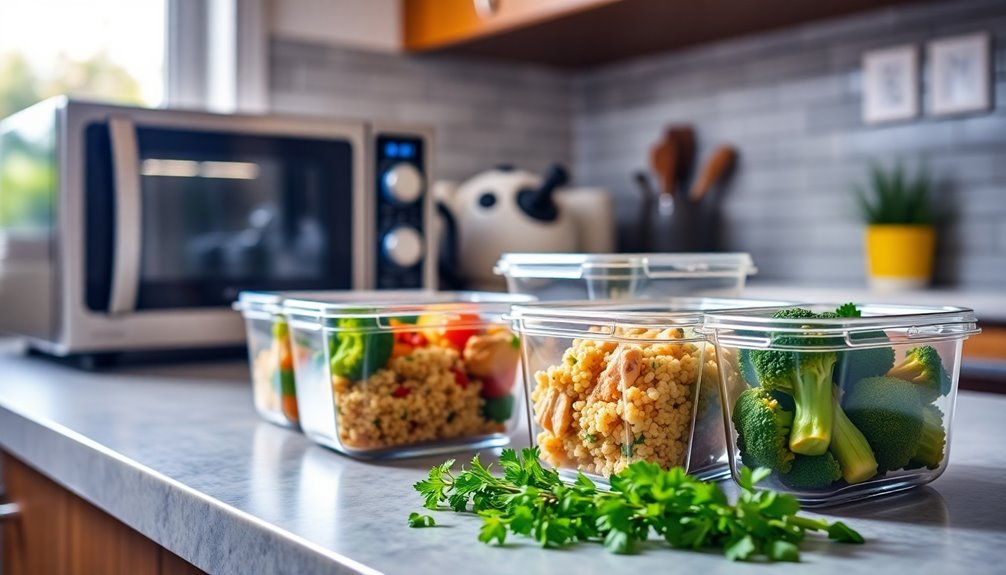
After storing your meal prep containers correctly, the next step is to make sure you reheat your meals safely. Maintaining food safety is essential to avoiding foodborne illnesses, and following these reheating tips can help you enjoy your meals without worry.
First, always aim for a temperature of at least 165°F (74°C) when reheating leftovers. This temperature kills harmful bacteria that may have developed during storage. Use a food thermometer to double-check if you're unsure. If you're using a microwave, stir the food halfway through to promote even heating.
Here's a quick guide for reheating different types of meals:
| Meal Type | Reheating Method |
|---|---|
| Proteins | Oven or stovetop |
| Grains | Microwave with water |
| Vegetables | Steamer or microwave |
When reheating, avoid leaving food out at room temperature for more than two hours. If you're reheating a large batch, consider reheating only what you'll eat to minimize waste and maintain freshness.
Lastly, don't reheat food more than once. Each time you do, the risk of bacteria increases. Remember, practicing good food safety isn't just about following rules; it's about caring for yourself and those you share your meals with. By sticking to these reheating tips, you'll not only enjoy delicious lunches but also foster a sense of belonging within your community, all while keeping food safety a priority. Additionally, incorporating whole food sources of protein into your meals can further enhance your overall health and energy levels.
Tips for Meal Prep Success
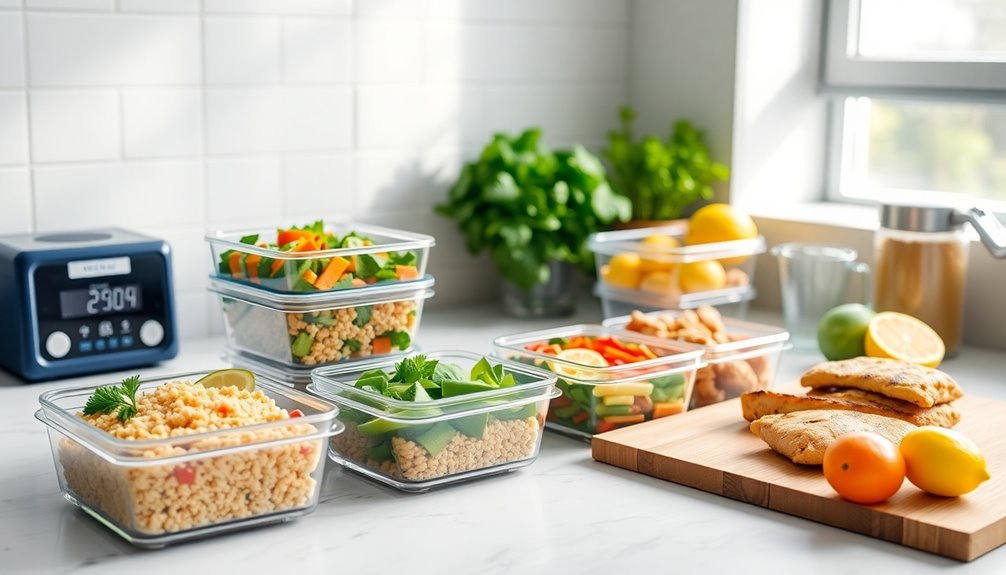
Successful meal prep starts with planning ahead to make certain you stay organized and efficient throughout the week. By incorporating effective time management strategies, you'll guarantee that your meal prep sessions are quick and productive. Here are some tips to help you succeed:
- Choose a day for prep: Designate a specific day each week to prepare your meals, allowing you to create a routine.
- Make a shopping list: Stick to a budget by listing all the ingredients you need, focusing on budget-friendly options that provide value without compromising nutrition.
- Batch cook: Prepare larger quantities of versatile ingredients, like grains and proteins, to mix and match throughout the week.
When you plan ahead, you'll not only save time but also reduce stress during busy weekdays. Consider using containers that fit well in your fridge or are microwave-safe, making it easy to grab a meal on the go.
It's beneficial to keep your meals visually appealing too; colorful plates can make healthy eating feel more enjoyable and inviting. Additionally, exploring keto diet benefits can provide further motivation to maintain your healthy eating habits.
Don't forget to incorporate seasonal produce into your meals, which can often be more budget-friendly and taste better. By being mindful of your budget and planning efficiently, you'll foster a sense of belonging in your meal prep community, sharing ideas and inspiration with friends or family.
Frequently Asked Questions
How Do I Prevent My Meal Prep From Becoming Boring?
To prevent your meal prep from becoming boring, embrace flavorful variations and creative presentation. Experiment with ingredient swaps—try different proteins or grains to keep things fresh.
Incorporate seasonal produce for vibrant colors and tastes; it'll make your meals more exciting and nutritious.
Don't forget to play with spices and herbs to add depth. By mixing it up, you'll look forward to your meals and enjoy the process of preparing them!
Can I Freeze All Meal Prep Ingredients?
Imagine you've just prepped a week's worth of vibrant veggie stir-fry. Can you freeze all those ingredients? Yes, but not every ingredient stores well. For best ingredient storage, use airtight containers and label them with dates.
Freezing tips include blanching vegetables like broccoli before freezing to maintain texture and nutrients. Proteins can also be frozen, but be mindful of their freshness.
You'll enjoy your meals without compromising flavor or quality!
What Should I Do if I Run Out of Ingredients Mid-Week?
If you run out of ingredients mid-week, don't stress! You can always make emergency substitutions with what you have on hand.
For instance, swap quinoa for rice or use frozen veggies instead of fresh ones.
If that doesn't work, consider quick grocery trips to restock essentials. Planning these trips can save you time and keep your meals balanced.
How Can I Incorporate Leftovers Into My Meal Prep?
Imagine transforming last night's dinner into a delightful lunch! You can easily incorporate leftovers into your meal prep by exploring creative combinations.
Think about repurposing leftovers—mix roasted veggies with grains for a hearty salad or blend them into a flavorful soup. Add spice blends to elevate flavor variety and keep things exciting.
Are There Meal Prep Options for Special Dietary Needs?
When considering meal prep options for special dietary needs, you've got plenty of choices!
For gluten-free options, focus on ingredients like quinoa, brown rice, and fresh vegetables.
If you're looking for vegan alternatives, legumes, nuts, and plant-based proteins can easily be incorporated into your meals.
Experiment with different spices to enhance flavors, ensuring your meals are both satisfying and accommodating.
With a little creativity, you can enjoy delicious, inclusive lunches that cater to everyone's needs.
Conclusion
By embracing meal prep, you're not just saving time; you're crafting your own culinary adventure, reminiscent of the heroes who prepared for epic journeys. With balanced meals at your fingertips, you can conquer the week with energy and focus. Remember, the key lies in planning, quality ingredients, and smart storage. So, gear up, channel your inner chef, and turn your kitchen into a domain of health and convenience. Your taste buds—and your body—will thank you!

